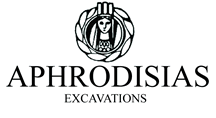History
Hellenistic & Augustan periods
Aphrodisias was founded as a Greek city-state in the early second century BC, in the wake of the intensive urbanization of the Meander valley region promoted by the Seleukid kings based in Hellenistic Syria. Unlike nearby Antioch on the Meander, however, Aphrodisias was not a royal colony. It probably owed its existence instead to the initiative of leading local landowners, who wanted the perceived benefits of city-status. As an important local source of communal identity, the pre-existing sanctuary of Aphrodite was an obvious choice for the site of the new town.
In the first century, Aphrodisias appears a few times on the stage of ‘international’ history, already as a loyal friend to Rome. In 88 BC the city sent help to a Roman commander besieged in nearby Laodikeia by Mithradates VI of Pontos. The Roman general Cornelius Sulla sent a gold crown and an axe with a dedication to Aphrodite. Julius Caesar also made an expensive offering to Aphrodite, a golden statue of Eros, perhaps when he was campaigning in Asia Minor in 47 BC. As Sulla before him, Caesar was exploiting a perceived connection between the Aphrodisian Aphrodite and the Roman Venus-Aphrodite, mother of Trojan Aineias and foremother of the Julian family. In 41/40 BC, the city fiercely resisted the invasion of Labienus, a renegade Roman commander backed by Parthia, and was rewarded for its outstanding loyalty in 39 BC by the Roman Senate with privileges that were the basis of the city’s future prosperity: autonomy (‘freedom’) within the Roman province of Asia; exemption from all taxes paid to Rome; and asylum rights for its sanctuary (eleutheria, ateleia, asylia).
In 39 BC we first meet a remarkable Aphrodisian, C. Julius Zoilos, a former slave of Octavian-Augustus who was probably instrumental in securing the coveted privileges and who was sent back to his home city to run things there. He was clearly the most powerful figure in town through the 30s and into the 20s BC. The earliest large marble buildings at Aphrodisias belong to this time and were his work. He built the Theatre’s marble stage building, the north stoa of the Agora, and the first marble temple of Aphrodite. And he received at least two honorific statues. It was with Zoilos that Aphrodisias began its urgent programme of public building, to bring a small polis community focused on its famous temple up to speed, to give the city a proper urban profile. The only other surviving dated monument of this period is, significantly, the great frieze from Zoilos’ own tomb monument.





